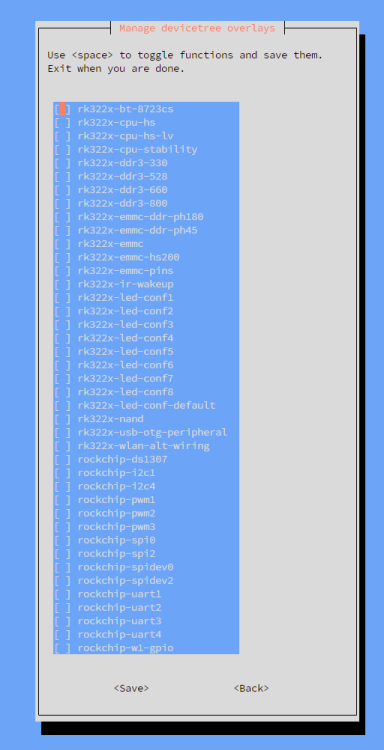Active threads
Showing topics posted in for the last 365 days.
- Past hour
-

sleep & wake on same pin for NanoPi Neo v1.4 Armbian-23 6.1.63
Dandaman46 replied to dandan7932's topic in Allwinner sunxi
Hi Dan, how did you go with this one. Any luck? I didn't know these chips supported sleep and hybernate modes. - Today
-
hello, agesome! The same thing happened to me, test 20mhz (20000000), I suggest increasing above 32mhz and test. I'm using mine at 46mhz and it's normal, but it used to give an error, it wouldn't update the screen, it would freeze, now it's normal because I disabled “dma-names=””;” Try it and let me know.
- Yesterday
-
I tried, unfortunately the other one I have here at home doesn't recognize when I use it. To try another one, I'll have to buy a new one... =(
-
I have uploaded an updated version here. Also, for thoses who want to use internal emmc (boot without sdcard), you can run this script: You can reinstall android using this, connecting DQ08's usb2 port (using a male-male usb cable) to the computer while pushing the button in the AV connector. Then, in the app (extracted to c:\), choose firmware / firmware.bin / restore / run.
-
Armbian_community_25.5.0-trunk.538_Orangepizero2w_bookworm_current_6.12.23_minimal.img When try to boot. It get stuck trying to boot from emmc. It does not have emmc. After several power restart sometimes it boots form microsd. also it ask for tags which has only one option "Solved". I had to tag this topic as solved in order to be able to submit it.
-
At a guess, you are probably running the panthor gpu driver rather than the mali kernel driver. To check this, run something like: sudo dmesg | grep -i panthor and report what comes back. Further information can be found at https://forum.jellyfin.org/t-rockchip-transcode-missing-dev-mali0 Hope this helps,
-
This week, the Armbian development team pushed several noteworthy enhancements, with improvements spanning user experience, bootloader upgrades, and broader system support. Notably, this week saw the debut of OpenMediaVault in Armbian’s software installer, a move that brings plug-and-play NAS functionality to supported boards. OpenMediaVault is a feature-rich platform that enables users to turn single-board computers into fully-fledged network storage devices. Thanks to a contribution by Igor, the integration is now available through armbian-config interface, giving users a streamlined way to install and configure OpenMediaVault without needing to manually manage services or packages. The usability of the software stack also saw a meaningful improvement. A previously persistent “Disable Wireless Hotspot?” prompt was eliminated when no hotspot had been enabled, reducing unnecessary friction during the setup process. This fix helps clarify Armbian’s default network behavior for users during first boot, particularly when configuring headless or appliance-style deployments. On the hardware front, the Orange Pi 5 Max received a key upgrade: it now boots using mainline U-Boot. This transition replaces vendor-specific boot code with upstream-supported U-Boot, easing future updates and kernel integration. A related improvement was made to the PocketBeagle2, which migrated to extlinux for boot configuration—bringing it in line with Armbian’s broader standardization efforts. Further enhancements came to the Rockchip64 platform. Previously missing Operating Performance Points (OPPs) were added to ensure proper voltage and frequency scaling across supported boards, which improves energy efficiency and stability under load. In addition, older workarounds for wireless firmware issues were removed, as upstream drivers have now resolved the compatibility concerns that necessitated them. Finally, infrastructure refinement continued with the cleanup of unused or deprecated build artifacts, keeping the codebase lean and future-proof. The team also laid the groundwork for upcoming testing initiatives to ensure that new features like OpenMediaVault are validated across a wide array of supported devices. For those interested in exploring OpenMediaVault or other curated software installations, the updated documentation is available in the Armbian Software User Guide. The post Armbian Updates: OMV support, boot improvents, Rockchip optimizations first appeared on Armbian. View the full article
-
Using screen is sufficient. No settings besides baud rate (115200 for any Allwinner) need adjustments. As mentioned above make sure your serial device is correct. If you are unsure, simply - unplug - run sudo dmesg -ew - plug in and check output in the terminal with the command above. Also make sure wiring is correct. Ground to ground and rx/tx crossed.
-

Armbian uses PIRACY TRACKERS to distribute images????????
Werner replied to dr_toggleswitch's topic in Off-topic
You don't have to trust/use torrents to download Armbian. All images are available via http/s download as well. We cannot do anything against people (ab)using torrent protocol for non-legal things nor can we control where these torrents spread/end up if this is your main concern. If you are concerned that an images you have downloaded is non-geniune run a check before proceeding with installation: https://docs.armbian.com/User-Guide_Getting-Started/#download-and-verfication - Last week
-
You could use this tool to extract your dram settings from an android update or boot0.bin. https://github.com/apritzel/sunxi-fw sunxi-fw info -v boot0.bin
-

PiRogue installation for NanoPI_R4S problems
Igor replied to Superuser's topic in Software, Applications, Userspace
From logs I can only conclude that problems are at your side - wrong configuration. Anyone can help you - problem is almost certainly not Armbian specific. May 10 21:05:09 pirogue systemd-helper[8502]: dnsmasq: unknown interface end0 May 10 21:05:09 pirogue dnsmasq[8502]: unknown interface end0 I am not an expert of application you try to install, in fact I never heard about until now. -
Yes, I installed the efi version on SPI when I thought I could boot UEFI images that way. And that's what I kept because I had no problem booting other uboot images, like the joshuas archlinux one I'm currently using to write this. Now I'm downloading the last one you posted because I'm so stubborn. But after that, I plan to boot with version 20240201-current to install a new uboot on SPI.
-
I went back to the default Armbian rootfs. The Arch rootfs broke the boot, probably due to the use of the latest systemd. It is possible to mitigate this but it is not worth it. Now I am running normally from the sdcard, I just wanted help with the armbian-config options. I know that led-conf7 and uart2 are correct for my board, right? I'm still looking for the others in the thread And what do I have to do to make the wifi work?
-

Analog Audio out not working (25.2.1 / 6.1 kernel / KDE Neon)
deskwizard replied to deskwizard's topic in Orange Pi 5
Thanks for all the info! As I can see the device fine, I'm assuming my DT is alright. I think I'm going to try some other images (ie. debian, main kernel, etc...) and see where it leads me, maybe I can get a hint of what's happening. I can change devices fine in KDE, the jack detect works as I see it toggle, but I don't get anything out. HDMI audio works fine though. I've seen some weird audio stuff a long time ago, I'll see what little I can remember since it doesn't seem to be something blatantly obvious. I have a hunch or two but unlikely to make any difference Ubuntu making it worse doesn't sound good to me... hehehe (pun intended) I'm planning to use it as a 2nd desktop/media player, most of the time I don't need the "power" of the "workstation" so running the opi works great (well, will hopefully) I went with KDE since that's what I'm using on the "workstation". To be honest, there's very high probabilities I'm going to buy a USB sound card and be done with it, but it feels like a waste. -
It was solved https://github.com/armbian/configng/issues/344 , but It looks like bug with overlay_prefix back again
-
So I decided to modify the armbianEnv.txt with the values you provided and it has moved to "Starting kernel..." It is taking quite a while to boot. The older version seemed to take quite a while as well but this seems to be hanging possibly. I tried changing the armbianEnv.txt verbosity to 7 but it is still stuck on Starting kernel... U-Boot 2024.01-armbian-2024.01-S866c-P7738-Ha5c2-V1f00-Bb703-R448a (Mar 16 2025 - 04:03:33 +0000) Allwinner Technology CPU: Allwinner V3s (SUN8I 1681) Model: PineCube IP Camera DRAM: 128 MiB Core: 47 devices, 20 uclasses, devicetree: separate WDT: Not starting watchdog@1c20ca0 MMC: mmc@1c0f000: 0, mmc@1c10000: 1 Loading Environment from FAT... Unable to use mmc 0:1... In: serial@1c28800 Out: serial@1c28800 Err: serial@1c28800 Autoboot in 1 seconds, press <Space> to stop switch to partitions #0, OK mmc0 is current device Scanning mmc 0:1... Found U-Boot script /boot/boot.scr 5475 bytes read in 2 ms (2.6 MiB/s) ## Executing script at 41900000 U-boot loaded from SD 227 bytes read in 1 ms (221.7 KiB/s) Load fdt: /boot/dtb/sun8i-s3-pinecube.dtb 12286995 bytes read in 509 ms (23 MiB/s) 11013984 bytes read in 456 ms (23 MiB/s) Found mainline kernel configuration 19691 bytes read in 4 ms (4.7 MiB/s) Working FDT set to 41000000 Kernel image @ 0x41080000 [ 0x000000 - 0xa80f60 ] ## Loading init Ramdisk from Legacy Image at 42080000 ... Image Name: uInitrd Image Type: ARM Linux RAMDisk Image (gzip compressed) Data Size: 12286931 Bytes = 11.7 MiB Load Address: 00000000 Entry Point: 00000000 Verifying Checksum ... OK ## Flattened Device Tree blob at 41000000 Booting using the fdt blob at 0x41000000 Working FDT set to 41000000 Loading Ramdisk to 42248000, end 42dffbd3 ... OK Loading Device Tree to 421da000, end 42247fff ... OK Working FDT set to 421da000 Starting kernel ...
-
https://libera.catirclogs.org/linux-amlogic/2023-11-18# It appears the bl30 blob is the only non free software file required for the le potato. What can you tell about the bl30 blob? Can it get reverse engineered? Where can you get the bl30 file? Thanks.
-

Buying advice: H96 Max V56 or X88 Pro 20?
Energokom replied to caminati's topic in Rockchip CPU Boxes
If you don't need GPIOs, don't take SBCs - they are too expensive, without a case and power supply. For the same money, you can buy a mini X86 PC such as razen5 4600 and you will have no problems with support. If you need an ARM, then buy an H96 Max V56 from two TV boxes. The time of SBCs has come to an end - they are no longer so popular and are mainly needed by developers. Leave these SBCs to the developers! -

/var/log constantly full = at /dev/zram1
killronaldreagan replied to pdieguez's topic in Orange Pi 5
I was looking for a solution to this for a long time before seeing John's post and figuring it out. Here's a more explicit explanation to hopefully help make this info easier to find. This was tested and does work on both the Orange Pi 5 16GB, and the Orange Pi Zero 3 4GB. I haven't run into this issue on my x86 nodes as it doesn't appear zram exists on them at all on a fresh install. If you go to the /etc/default directory, there should be a file called <distro>-ramlog. If you're on armbian it will be armbian-ramlog, for me on Debian it's called orangepi-ramlog. In this file there will be a line reading "SIZE=50M" Simply edit this line to whatever value you'd like, and then reboot the device. If rebooting the system will cause serious problems, you can use the following command on armbian: service armbian-zram-config restart Again, I'm using the official Orange Pi Debian image, so for me, the command would instead be as follows: service orangepi-zram-config restart Don't panic if you notice that this command results in the creation of a zram2 and zram3, as these duplicates will automatically remove themselves the next time you reboot the machine -
Hi catotinha, Can you please share which image you successfully used, and where you downloaded it from, please? Thanks!!
-
Hi Pilinha and Werner. My problem was that I misidentified the board and thus installed the wrong software. https://forum.armbian.com/topic/51779-orange-pi-plus-2e-usb-ports-not-working/ Thanks for your help, I learn a few things here.
-
OK .. now i must "cleanup" all voltage regulators
-
https://www.loverpi.com/collections/le-potato It says open-source support. Free software is software you may use, share, modify and redistribute. Can le potato run entirely on free software, such that there is no piece of non free software on the computer? If so are the armbian le potato images free software images? https://www.armbian.com/lepotato/ Thank you.






